A Full Guide to LiveOps in Games 2024
 Gabriel Kuriata
Gabriel Kuriata This is a guest article by Julia Iljuk, Co-founder, Head of Growth at Balancy. Over the last 7 years, Julia’s been helping game studios to monetize games better and smarter. Balancy is your go-to platform to scale LiveOps and increase LTV in games.
As we head into 2024, one thing we know for sure: mobile gaming studios will have to run LiveOps with speed like never before. The cost of every installation is increasing, and monetization is becoming more challenging. These trends are forcing developers to focus on content quality and personalization versus how big the scale of their user acquisition is.
Most developers think: “My game is ready for live operations because it has a good in-game shop with various products. Also, we have a couple of hardcoded special offers and run several seasonal events throughout the year, such as Christmas and Halloween. Our players seem to be happy.”
The idea of this article is to give you a competitive advantage over this common way of thinking. In 2024 the race will not be about whether or not your game uses some LiveOps tactics but how well your studio’s infrastructure and team can support an infinite pipeline of tests and user-level game personalization.
We start the guide by looking at the most up-to-date definition of LiveOps. Next, we will discuss the industry’s new challenges, and how studios will adapt. We will wrap it up by outlining eight essential pillars of your LiveOps strategy to succeed in 2024.
You’ve heard about live operations many times and may think you know everything about it. Yet when you try to define the term, it turns out to be vague and includes everything from in-game events and promotional sales to support and community work.
LiveOps strategies help games become living and evolving organisms versus the ‘create – release – start a new project’ approach. When you run a game as a service, the release date is the beginning of a new life. Like a new organism, your game is evolving, keeping players constantly coming back for more fun and fresh experiences.
Let’s define LiveOps the following way:
LiveOps are changes and updates you bring into the game after the release date to engage your players, create long-term relationships with them, and improve the LTV of your game. In an ideal scenario, these updates are handled by the product team and do not require the involvement of developers.
Here are some examples of what LiveOps in games are and are not:
✅ Launching a game pass with free and premium reward tracks.
A pass in games typically includes a structured progression system that allows players to earn in-game rewards by completing challenges, missions, or objectives. These rewards often consist of cosmetic items and in-game currency. Examples are the Royal Pass in Royal Match and the Battle Pass in Fortnite.
✅ Adding skimming pricing and real-time pricing strategies to your game shop.
Skimming pricing, or cascade pricing, is initially setting a relatively high price for an offer and subsequently lowering it over time. Check this case study of the Balancy team with the Hot Siberians studio to see how the cascade pricing works (experiment 1).
Real-time pricing, or dynamic pricing, is adjusting prices on the fly in response to market demands and different user characteristics (often implies the use of ML/AI technologies).
✅ Adjusting the frequency of ads for various segments of players.
For example, you can increase the ad frequency as the player progresses through levels to improve retention among newcomers. In this video, you can see the deconstruction of such a tactic tested by the Supersonic team.
✅ Decorating a game for a seasonal celebration and launching a sale.
One of the most common and proven templates for your LiveOps strategy is combining in-game events and promotional sales. Sales are usually coupled with events to create urgency to buy. You can make a time-limited Black Friday sale with huge discounts or start selling new winter skins around Christmas time as a part of your winter in-game season.
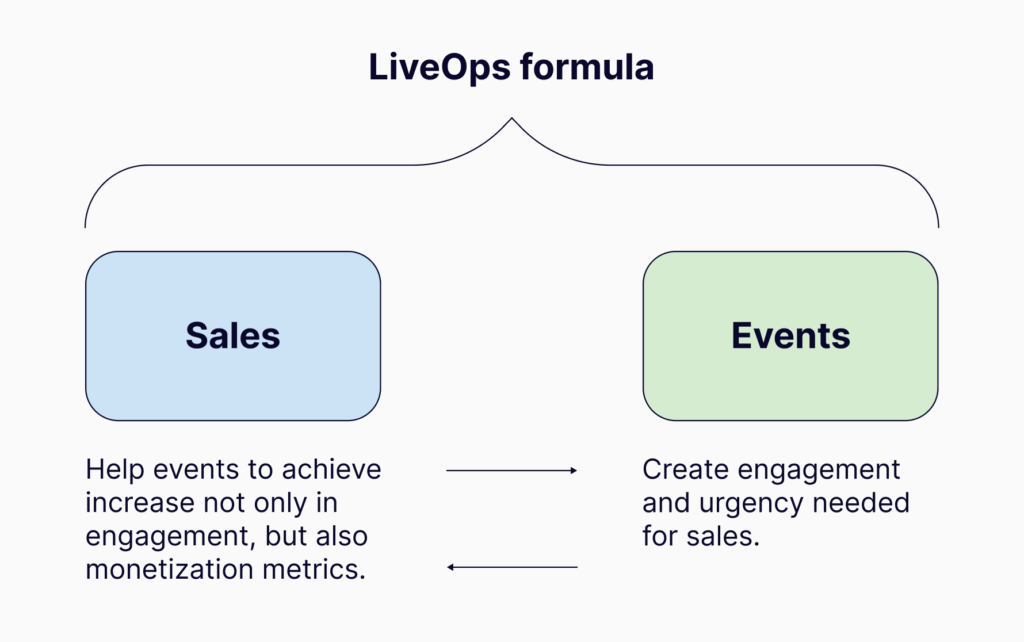
✅ Promoting your time-limited event or tournament on social media, where your community gathers.
✅ A/B testing a new push notification message for churned users.
❌ Bug fixes and app productivity optimization.
These changes do not directly increase the LTV of your game, therefore, we do not include them in LiveOps.
The LiveOps examples described in this section are just a few most common templates. In reality, these tactics are limited only by your imagination and resources (such as employees and tools). However, new technologies for running no-code content updates make these limitations less of an issue.
Due to these technological advancements together with market uncertainty, we will be viewing many new creative tactics coming up. Later on in this article, we dive more into Custom FTUE (first-time user experience) as an example of a rather new personalization tactic that helps marketers improve the retention of their campaigns.

On the one hand, LiveOps activities help games be attractive for new players with their high demands constructed by the dynamic market. On the other, it helps entertain and retain old loyal audiences, which is crucial today – here is why.
Games monetization has never been more challenging than today. Consumers are cutting their expenses everywhere, and games are not an exception. Games suffered a 16% drop in IAP in 2022. Ad monetization doesn’t look like a solid alternative to boost revenue either. It continually shows a negative trend in most countries, forcing studios that heavily relied on ads (hello, hypercasual) to reconsider their strategy and turn towards LiveOps.
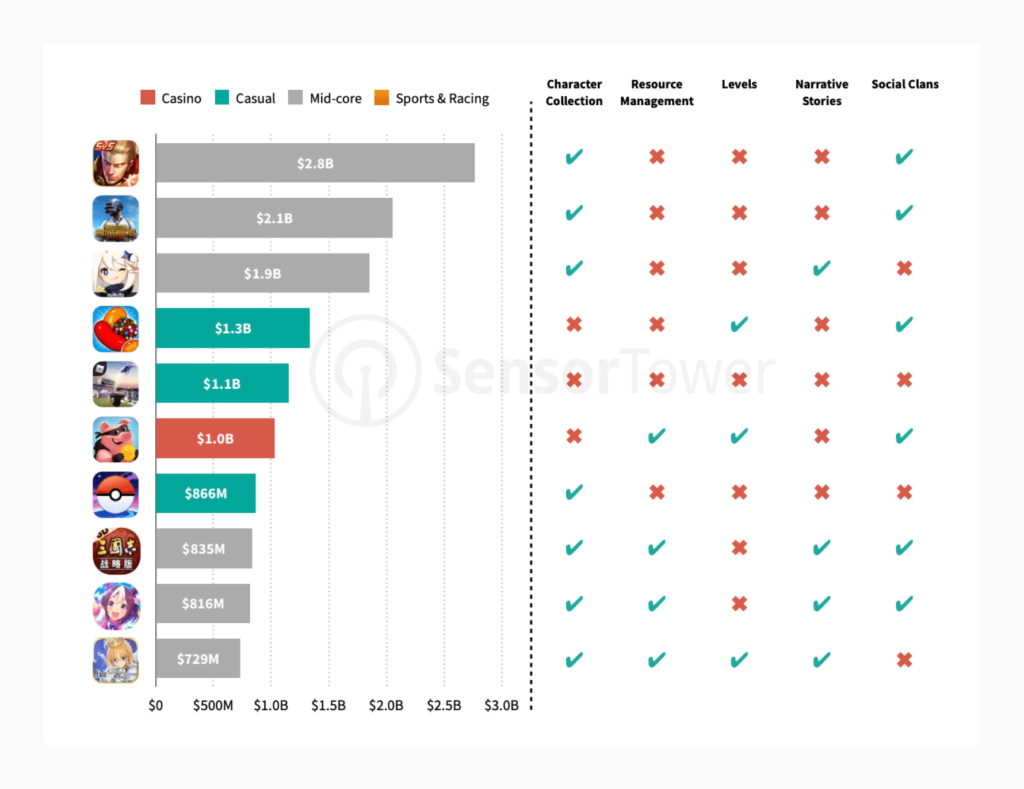
The latest Sensor Tower’s gaming report indicates that Live Ops is a primary monetization and retention element of top-grossing games that helps them maintain long-term player engagement and spending. The world’s top 10 mobile games in 2022 supported their titles through this approach.
Let’s not forget about one more challenge studios have to deal with: the state of UA is broken. In response to declining IAP and ad revenue, marketing budgets are shrinking – while CPI, on average, continues to grow. Studios start looking into the potential of organic installs and retention tactics because monetizing a loyal player is often cheaper than acquiring a new one.
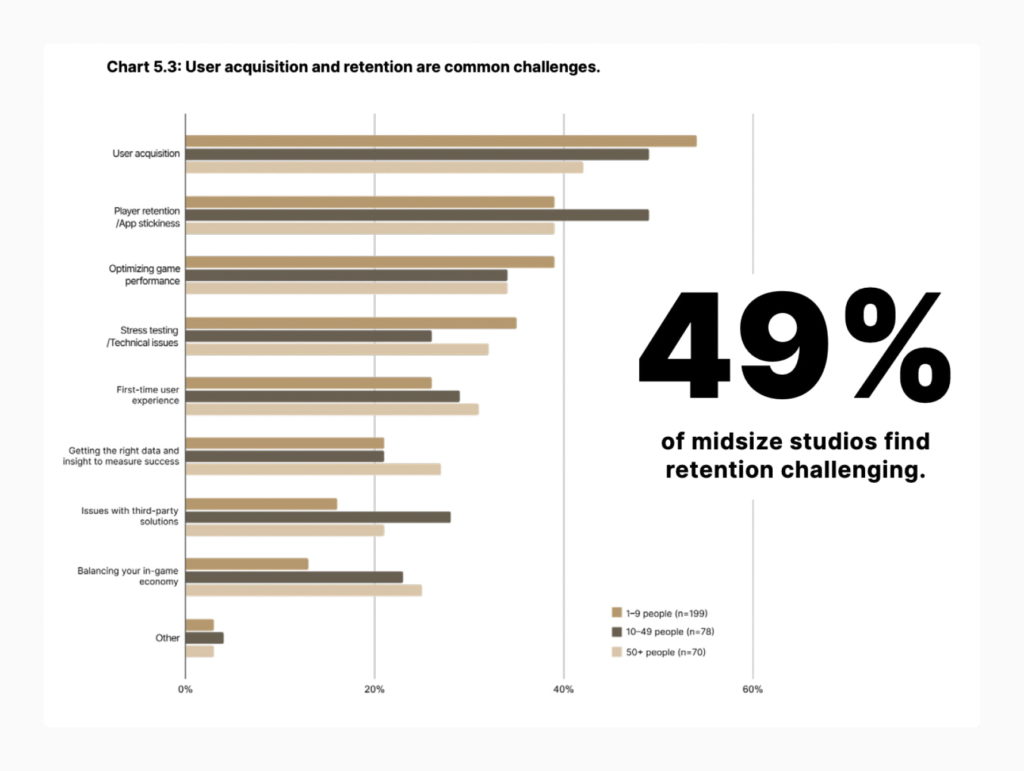
Along this line, Eric Seufert predicts that very soon “user-level personalization will create a competitive advantage and overtake user acquisition in terms of resourcing and internal studio infrastructure.” Game studios will have to compete on the quality and personalization of experiences rather than on how to attract more players.
It doesn’t mean, however, that paid user acquisition is dead, but rather that new practices will be adopted by marketers. The idea of custom FTUE (first-time user experience) for new players can become a defining one in the future, we will look at it in more detail further on in this guide.
How do LiveOps translate into monetization benefits for games?
For players, LiveOps brings a steady stream of fresh content, events, and challenges that maintain engagement and keep interest in the game. This approach ensures longevity, as the game remains relevant and interesting over time. It encourages community building, as players collaborate, compete, and interact during various in-game activities. Additionally, LiveOps allows players to customize their experience with in-game purchases, enabling them to tailor their gameplay to their preferences.
Developers, in turn, benefit from the monetization aspect of LiveOps, capitalizing on longer and more frequent sessions with in-game purchases of skins, boosters, and other enhancements. LiveOps can act as a marketing tool, attracting new players and retaining existing ones through promotional events. In addition, it’s great when while running LIveOps, developers establish a feedback loop, using real-time player input to identify players’ interests, resolve issues, and inform future updates.
Implementing LiveOps in games requires a strategic approach. It begins with understanding the player base and planning of the events calendar and finishes with thorough testing and analytics as the update goes live.
Developers should regularly analyze player preferences and trends, aligning LiveOps content with their interests. Segmentation is crucial; creating content and events that cater to different player groups enhances personalization.
Timing is vital — events should be scheduled to ensure a consistent flow of engagement without overwhelming players. They also should not be too predictable, otherwise, your players will always wait for this ‘every Friday sale’ and never buy anything on other days.
In-game purchases and rewards should be well-balanced, enhancing gameplay without creating a “pay-to-win” environment. Also, when planning a new event, developers are paying a lot of attention to it’s potential effects on the game economy not to create inflation of resources.
Measuring the impact of LiveOps is important for understanding how an event affects the game and for shaping future strategies. Key metrics, like player retention, engagement, conversion rates, and player feedback, serve as your compass in this journey.
Depending on the event’s purpose, different metrics take center stage. For example, if the goal was to encourage players to make their first in-game purchase, your primary focus would be on conversion rates. But if the aim was to bring back players who had stopped playing, the focus shifts to analyzing churned user re-engagement.
A/B testing plays a crucial role in assessing which event types, timing, and rewards work best. Player surveys and feedback channels provide valuable qualitative data, while tracking community sentiment through social media and forums is equally vital.
The post-event analysis extends to the game’s economy and the real impact on sales. Sales often result in a prolonged “hangover” period, where players don’t make purchases, which must be considered for proper evaluation of the event.
Although LiveOps may initially sound like a strategy mainly for product managers and game designers, it holds significant potential for marketers too. This potential becomes especially evident in the market conditions outlined above. The growth focus shifts from acquiring new users to improving the retention of the existing audience, making LiveOps a valuable strategy for marketers.
Nowadays, stores allow you to make a lot of custom pages with different presentations of the game, advertising sources allow you to bring people not to the default page but to custom ones. The next logical step is to give a personalized experience for new players inside the game – let’s call it a ‘custom first-time user experience’.
It’s time for marketers to remember that they are not just lead generators. Product and marketing teams must work hand in hand from the earliest stages of a product. Because at the end of the day, they will need to put different users on different roads throughout a game.
Imagine if players from your creative or campaign could be automatically directed to one of the multiple-game scenarios, which is the best fit for them. For example, players can be welcomed by a character they saw in a creative, rewarded with bonus diamonds they were promised in your ad, or, depending on their predicted paying capacity, shown different special offers in the game.

Now from market trends and concepts down to more practical implementation. Let’s look at several essential elements a LiveOps strategy should be built on to ensure your studio can stand this year’s competition. It’s a good list of points if you start planning your strategy from scratch or need revision.
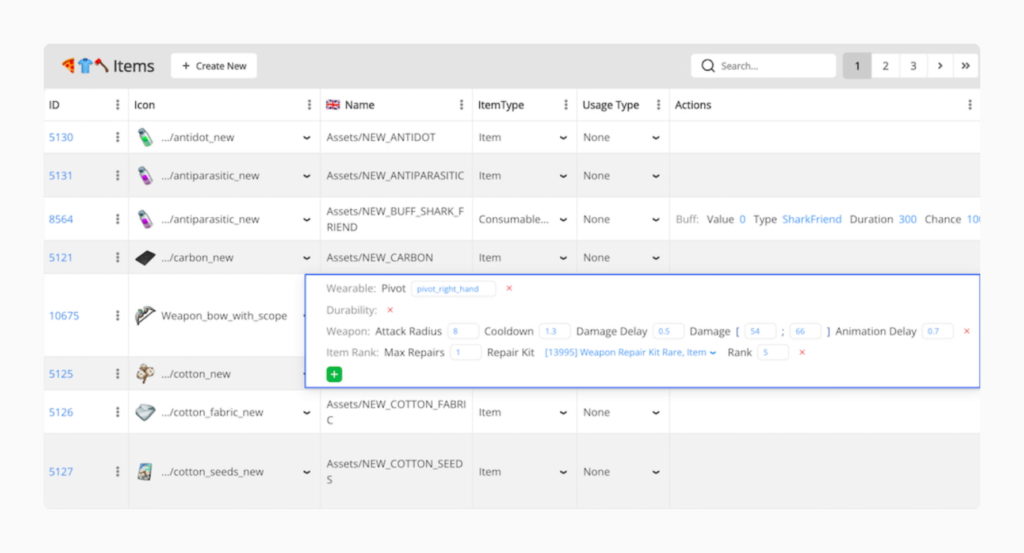
Your game certainly has many elements, such as boosters, characters, quests, skins, store items and offers – which can be summarized as your game content, or game balance. LiveOps often means creating and updating these elements – examples can be reducing the power of one character or increasing the reward for quest completion. This means you need a convenient system to store, manage, and deliver content updates to players at scale.
Usual spreadsheets will work fine initially, but you will quickly notice how they slow down your workflow, lack flexibility, and make it almost impossible to navigate hundreds of items. Besides, spreadsheets entail lots of risks related to human error – app crashes and broken game logic will be your companions when you deliver updated game balance from spreadsheets into your game.
To handle game content in a smart way, you need to develop a professional content management system (CMS) that doesn’t lag from the tone of content and provides straightforward navigation and data validation. Ideally, it should also be seamlessly connected to remote configs – the next essential component of your tech stack.
Remote config is a technology that helps developers change the appearance or functionality of their games remotely (without requiring users to download an app update).
How it works in most cases: a game designer updates game balance or offers in spreadsheets and brings these spreadsheets to programmers. Programmers do a bit of magic with JSON – and voila – changes to the game are made without releasing a new app version.
While JSON is definitely the most popular format to work with a remote config, it will not give you a competitive advantage. There are solutions on the market that allow you to change the game without working directly with JSONS, thus, accelerating your game design team and reducing the workload of programmers.
Imagine that your game designers can have complete power to turn the handles of the game economy and conduct events and sales remotely – this is the workflow to think about when operating your game live this year.
To increase your game’s LTV, you need to treat each user differently. Of course, it doesn’t make sense to target each user and create millions of unique events and offers. That’s where segmentation comes in handy. It’s easier to group users into segments based on criteria and then target these segments.
You may want to offer a discount for paying players that haven’t purchased anything in the last month to activate them. Or it could be a good idea to reward whales with free exclusive skins to work on their loyalty and’ retention. It’s up to you to develop strategies, but make sure your tools are flexible enough to support your segmentation needs.
Besides the most popular RFM approach in segmentation (based on recency, frequency and size of payments), you can use other parameters for segmentation, such as players level/progress in the game, their ad watching activity, and what resources they have/lack in their accounts.
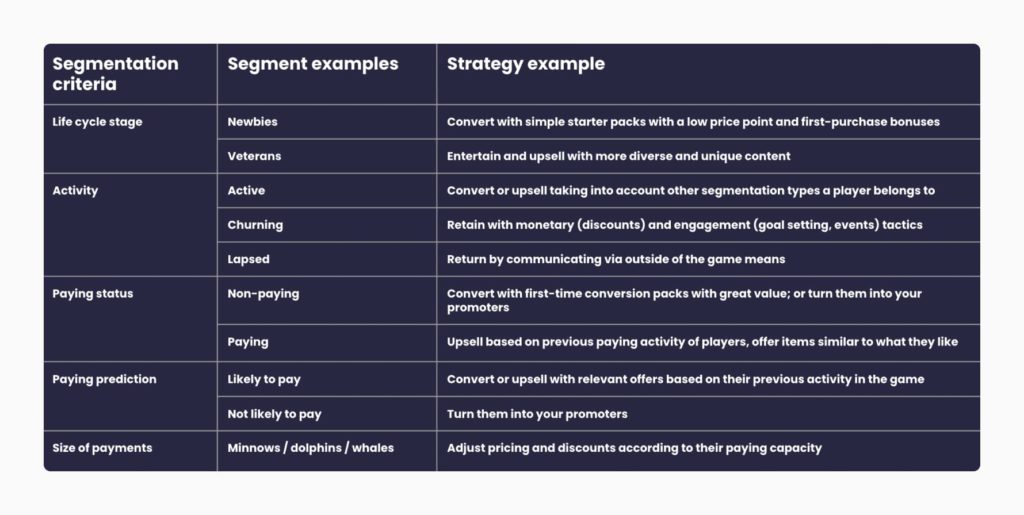
Your game has an in-game shop, however a rather big part of your revenue will be coming from special offers – in which you lower pricing for your standard shop products or provide additional value for the same money. Unlike LiveOps retention and engagement tactics, special offers’ impact on monetization is easily measurable and immediate – that’s why they are one of the favorite and most effective LiveOps tools out there. You create an offer, players make purchases, and you evaluate the sales metrics.
Even though there are some best practices for running offers, there is no universal formula that will work everywhere. Offers may vary even among games of the same genre, so you must conduct many experiments to find combinations of offer types and their placement that works for your game. This is why hardcoding offers in the game or using JSON does not look like a sustainable solution, if you are planning scale your LiveOps and run a lot of experiments.
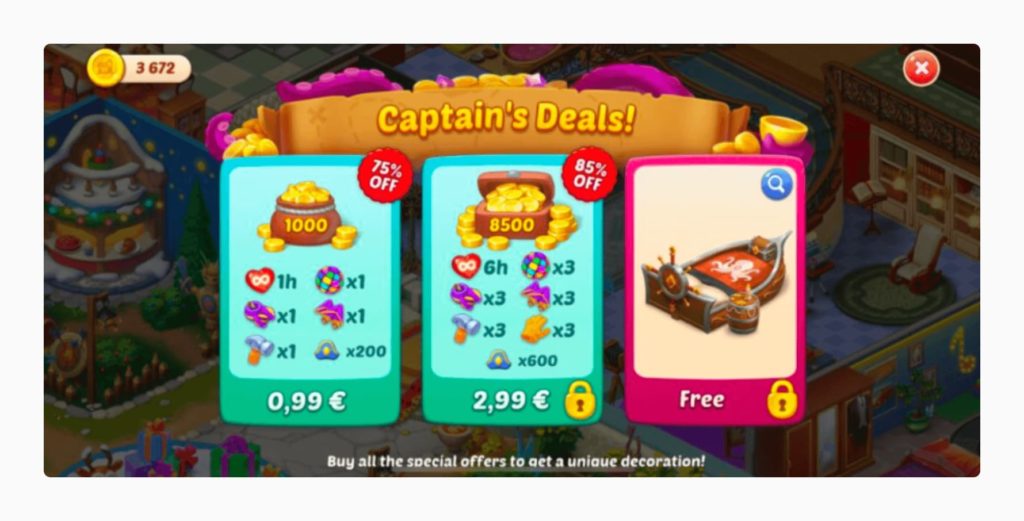
Another weakness of working with JSONs is that it’s more difficult to create offer dependencies (when one offer follows another one) and completely impossible to visualize these offer journeys. Offer journeys are the best approach to creating offers in games, because they take into account previous history of behavior and purchases. It allows to personlize shopping experiences, which translates into better conversion rates and higher checks from dolphins and whales. For example, when Hot Siberians created a promo journey with Balancy, it helped them to increase conversion by 37% and ARPPU by 50%.
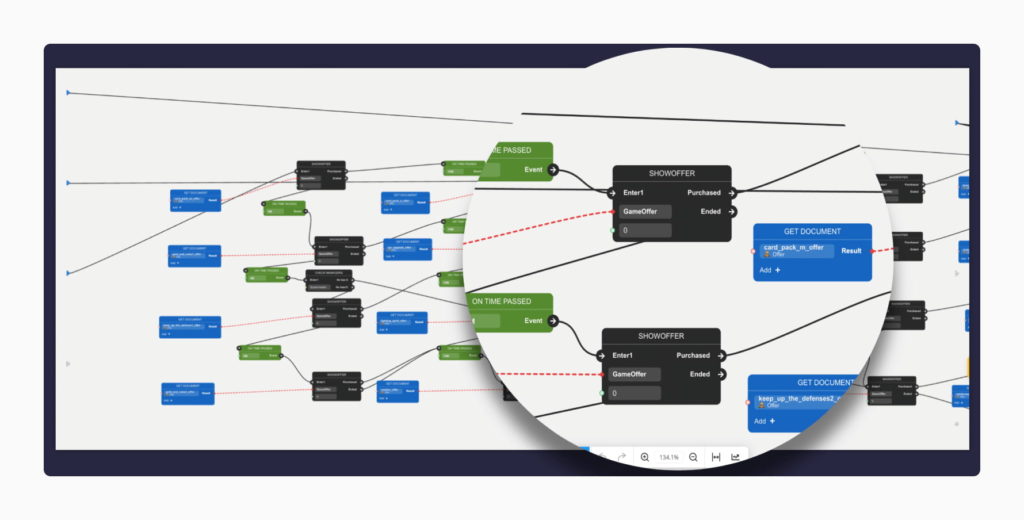
Events are a great tool to refresh your game, increase engagement of loyal players, and attract new ones. In search for inspiration, you can look around for real-life holidays (such as Easter, Christmas, and Halloween), major world events (for example, sports championships, iconic concerts, and movie releases) or create your own events, such as time-limited challenges and seasonal competitions among your players.
A good example of a game event related to major world events is Call of Duty Season 10: World Class released around the time of the FIFA World Cup 2022. During this in-game event, players were allowed to play as football legends Neymar Jr, Lionel Messi, and Paul Pogba. The soccer stars did not come for free – to unlock them, players had to pull their lucky draw using the premium currency.
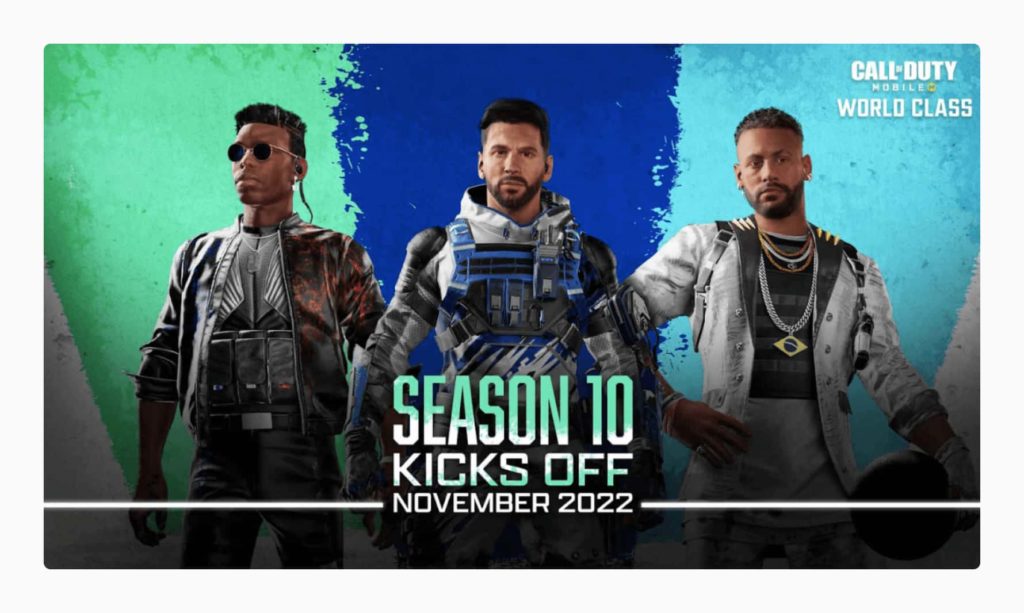
However, your event does not have to always be of a big scale and budgets. Casual games show great results by adding simple time-limited challenges to their gameplay, such as Sky Race in Royal Match. Here players are invited to complete more levels than other players to receive extra rewards.
When planning your events, keeping a calendar is the way to go. Again, you can adapt spreadsheets or Confluence for this purpose, but it’s so much more efficient to synchronize your calendar with a remote config system. So all changes in events, sales, and A/B tests from the calendar go straight away into the game. This will save you a lot of time that otherwise would go on keeping your spreadsheets constantly updated manually.
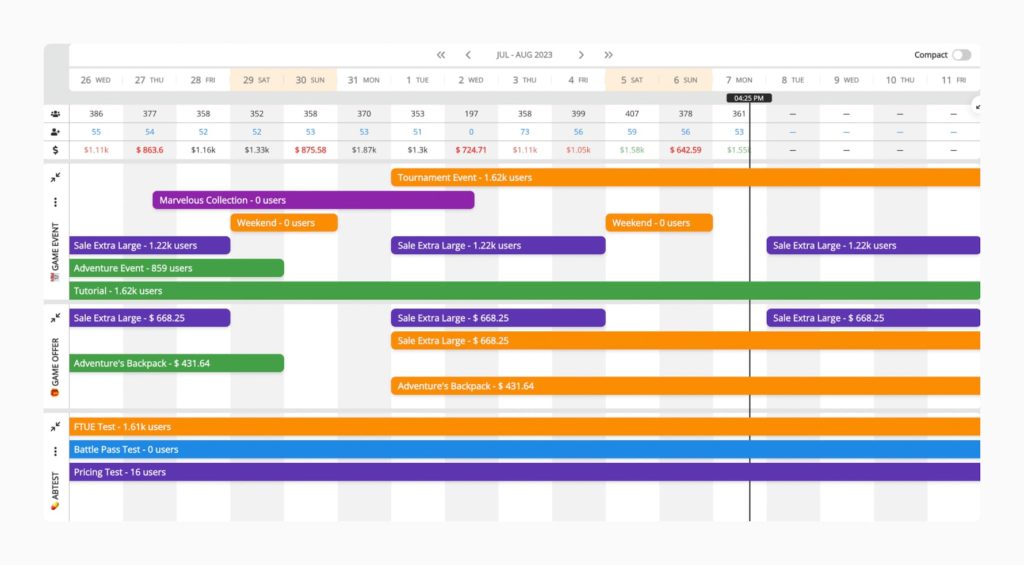
When you have a new idea, you can’t wait to try it and you tend to be sure about its success. But before releasing any changes for the entire audience, don’t forget to test it. Be that a new onboarding (FTUE), a special offer, custom pricing, or a new challenge – don’t rush and compare its performance with a control group of players playing the old version of the game.
Think in the direction of no-code A/B testing, where you can select segments of players and change their game experience remotely, as well as change it back quickly in case the test hasn’t shown desired metrics. You should be able to switch different versions of your game on and off like there is a lightning-fast remote control in your hands, and you should be also collecting all the important metrics to guide your decisions.
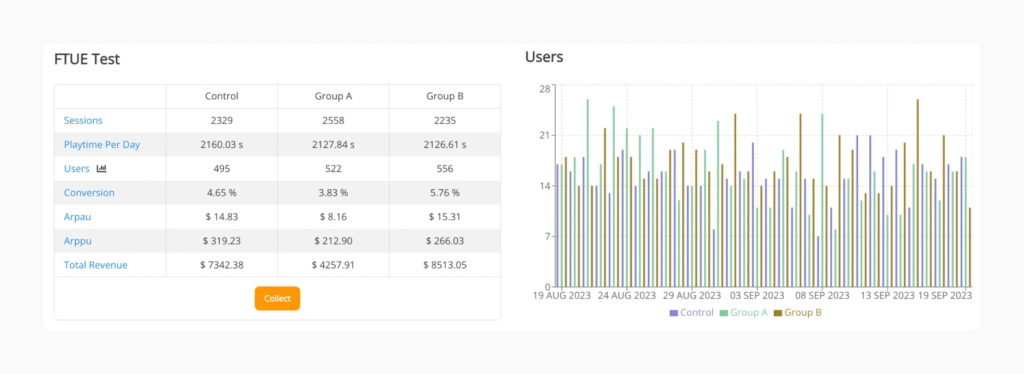
When it comes to Live Operations, data is king. When developers launch a new special offer or event, they must analyze the results to determine its effectiveness. Analytics provides insights into how many players participated, how much revenue was generated, and whether the offer or event was profitable. Don’t forget about the ‘hangover’ effect usually present after the sales are finished.
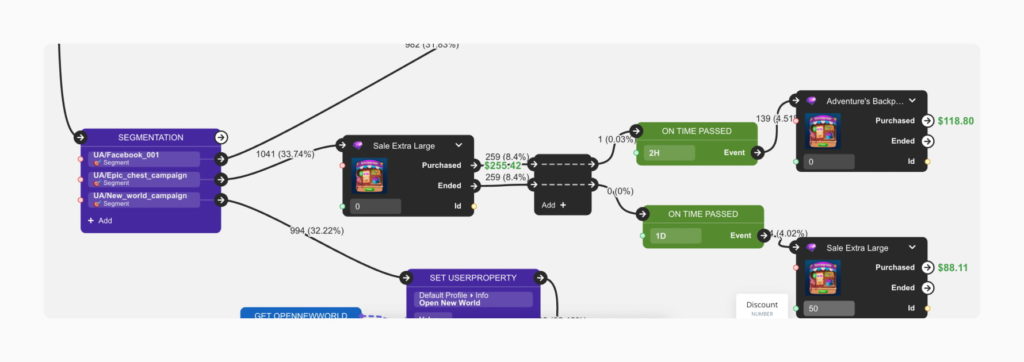
In addition to analyzing the results of special offers and events, analytics is critical in conducting A/B testing. By analyzing the data generated during A/B testing, developers can decide which version to release to players to grow target metrics. According to many developers, A/B test correct analytics is actually the most challenging and time-consuming part of LiveOps.
Messaging is another effective way to keep your players engaged, combat churn, and potentially improve monetization. You can announce new challenges and events, share your game’s news, make special offers, conduct surveys, or send gifts to players that haven’t been active for several days to avoid churn. The most popular game outreach channels are in-app messages, push notifications, and emails.
Personalization is a key trend in messaging for LiveOps, as it allows you to tailor your messages to individual players’ preferences and interests, resulting in higher engagement and conversion rates. Additionally, using data analysis and segmentation, you can target specific groups of players and improve your messaging strategy.
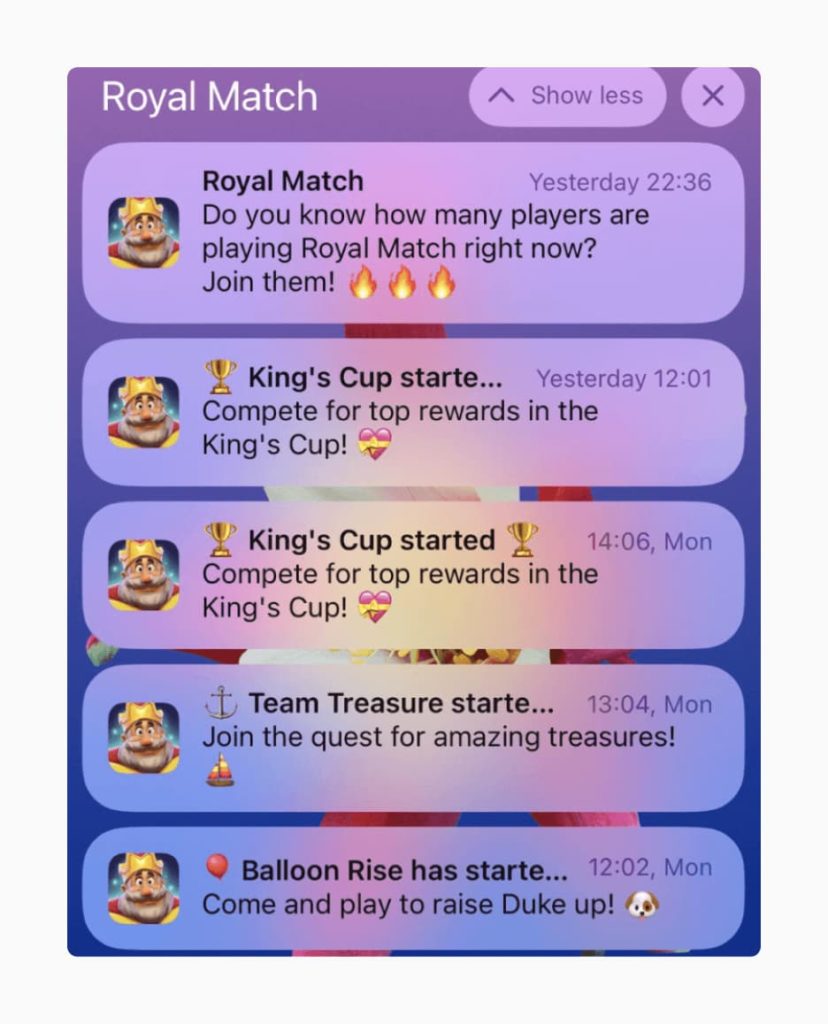
Community and support teams play a crucial role in LiveOps by serving as bridges between your product and players. These teams are responsible for communicating updates, organizing surveys, gathering feedback, and creating a solid community that people want to be a part of.
When you launch a new tournament, your community manager is the one to promote it on social media and explain its rules to players. When you’ve launched a new challenge that your players dislike, support managers that process store reviews are the first to notice the problem and raise the alarm.
It’s important to remember that the human aspect of the game is just as important as the technical aspect, and that’s why community and support teams are essential to the success of a live game.
Let’s Summarize key best practices to boost retention and monetization in your game.
In-game events are a fantastic way to maintain player interest. Regularly hosting events, such as tournaments or special challenges, can boost player engagement and retention. These events provide an opportunity for players to showcase their skills, compete with others, and earn rewards, creating a dynamic and exciting gameplay experience.
Strategically implementing in-app purchases is crucial for maintaining a healthy revenue stream. Offering relevant and correctly priced in-game items, power-ups, or skins can provide players with meaningful value and drive monetization.
Tailoring in-game experiences to individual player preferences can significantly enhance their immersion and enjoyment. This might include customized quests, item recommendations, or pricing adjustments based on paying capacity, which can all make players feel more connected to the game and more likely to spend in it.
User acquisition is not working as before, and making a profit from games is becoming more challenging. To ensure your game’s lasting success, LiveOps strategies are the key.
But it’s not just about offering deals and events to players. The real secret to success is how quickly your studio can scale LiveOps and personalize game experiences. Personalization will become the primary competitive advantage in the market, surpassing other growth strategies in terms of resources and internal studio infrastructure.
Is your studio ready for the 2024 LiveOps challenge?
